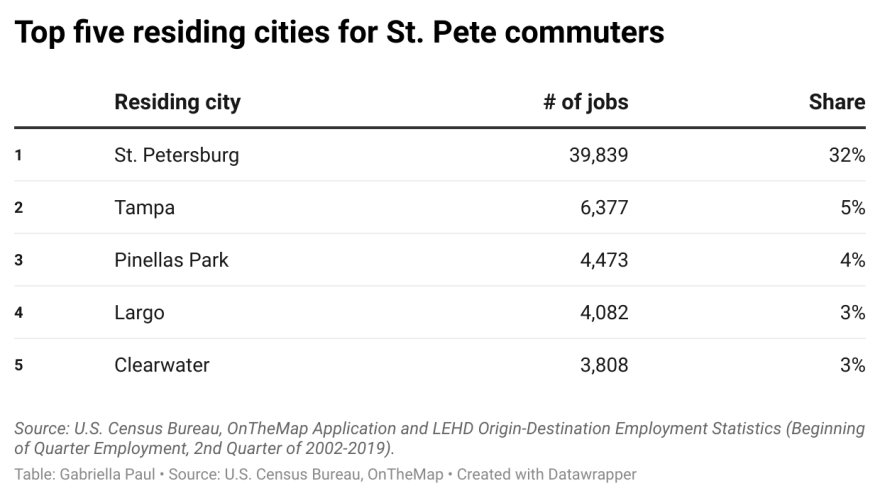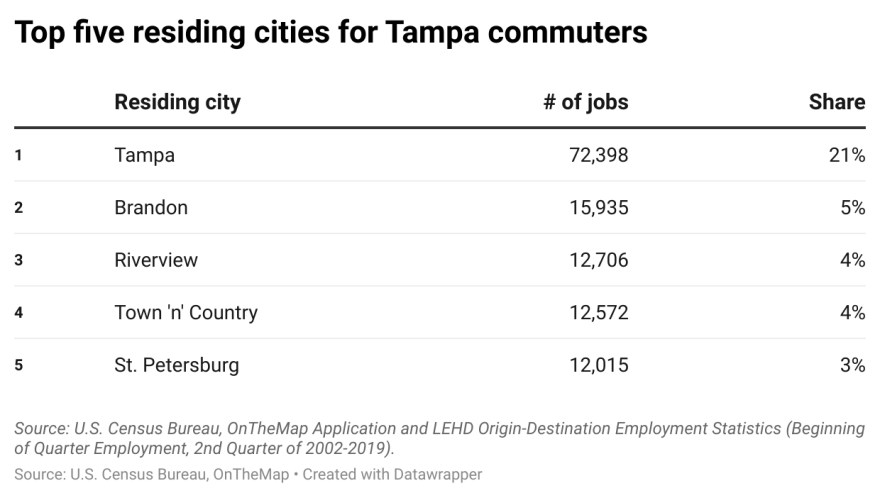In Tampa’s labor market, around two in three people commute across city lines to get to work, according to the latest transportation data from the U.S. Census Bureau.
The remaining third of the workforce both live and work in Tampa — a measurement that’s known as the city’s “self-containment ratio.”
Compared to other U.S. cities, Tampa’s self-containment ratio is very low, said Dr. Yujie Hu, a geographer and transportation researcher at the University of Florida.
“In this age of rising costs, I think this percentage is very likely to get even lower,” he said.
In Tampa's greater metro area, the ratio of people living and working in the labor market is much higher at around 80 percent.
Among those who are non-residents commuting to work within the Tampa-St. Petersburg-Clearwater metropolitan area, more than half earned less than $3,333 a month.
A high commuting rate in the labor market can indicate two things: a gap in affordable housing for those who work in the metropolitan area, or a need for new employment opportunities in neighborhoods where housing costs are cheaper.
“So, there’s a theory about people constantly making trade-offs,” Hu said. “The further you commute, the longer you commute – the more likely you’re able to find affordable housing.”
In the labor markets for St. Petersburg and Tampa, the highest percentage of non-residents commuted to work from nearby areas with cheaper median gross rent.


Hu said the decisions the labor force makes between commuting and housing costs is studied by urban economics researchers.
In a co-authored report published in January, Hu found that other factors — like age group — play into commuters’ relationship with housing and employment.
Following a statewide trend, the study found that millennials working in the Tampa metro are more likely to be commuters while baby boomers are more likely to work where they live.

Among those who live and work within city limits in Tampa, there’s also notable disparities among commuters’ experiences based on certain socioeconomic characteristics of the household.
In an analysis of U.S. Census Bureau data, Hu found the most drastic difference in reported commute times was between white residents living in newer, single-family homes and Black residents who are older and earning lower incomes.
Residents in the first neighborhood typically have the shortest average commute, of 15 minutes or less, while those in the latter disproportionately experience an “extreme commute,” of longer than 90 minutes, according to Hu.
This disparity in commuting time can mean an uneven distribution in everyday costs for affected workers.
After a year of rising fuel and maintenance costs for vehicles, one survey found that a majority of Americans were reconsidering their driving habits to cope with extra costs.
Though for some workers in the Tampa Bay area, who are unable to live where they work, foregoing a daily commute may not be an option.
Gabriella Paul covers the stories of people living paycheck to paycheck in the greater Tampa Bay region for WUSF. She's also a Report for America corps member. Here’s how you can share your story with her.





